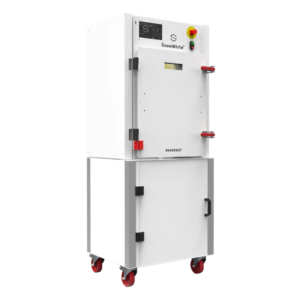Snowwhite2: Why a CO2 Laser for a SLS printer
In the field of Selective Laser Sintering (SLS) for thermoplastic materials, a key differentiator in machine performance lies in the type of laser employed. Analysis consistently demonstrates that SLS printers utilizing CO2 lasers generally outperform those using diode lasers in achieving high-quality, efficient, and versatile thermoplastic sintering. This article will explore the primary reasons behind the superior performance of CO2 laser-equipped SLS machines such as our Snowwhite2 and Snowwhite2-HT.
A significant advantage stems from the wavelength of the laser. CO2 lasers typically operate at a wavelength of 10.6 micrometers (µm), situated within the mid-infrared spectrum. This wavelength exhibits excellent absorption characteristics across a broad range of thermoplastic powders commonly used in SLS, including PA12, PA11, TPU, and PP. This efficient absorption directly translates into more effective melting and fusion of the powder particles, leading to higher part density, improved mechanical properties, and superior surface finish.
Conversely, diode lasers typically operate at shorter wavelengths, often in the near-infrared range (around 800-1064 nm). While some thermoplastics can absorb these wavelengths, the absorption rate is often less efficient and more material-dependent. This can necessitate higher laser power, slower scan speeds, or the incorporation of additives into the powder to enhance absorption. Even with these adjustments, achieving the same level of consolidation and part quality as with a CO2 laser can be challenging.
Furthermore, beam quality and stability are crucial for precise sintering. CO2 lasers generally offer a higher beam quality with a more Gaussian energy distribution. This allows for a finer focus spot size and more consistent energy delivery across the sintering area. The result is greater detail resolution in the printed parts and a more uniform sintering process, minimizing warping and other thermal distortions. Diode lasers, while their technology is advancing, often struggle to achieve the same level of beam quality, potentially leading to less precise sintering and lower part accuracy.
Power scalability also presents a critical difference. CO2 laser technology has a well-established capability of delivering high and stable power output, which is essential for sintering larger parts or achieving faster build times. Higher power enables faster scan speeds and the ability to sinter thicker layers, significantly increasing productivity. While the power output of diode lasers has improved, they generally lag behind CO2 lasers in terms of maximum achievable and consistently maintained power levels required for demanding industrial applications.
In conclusion, while diode laser-based SLS offers a more accessible entry point with potentially lower initial investment, for applications demanding high-quality parts with excellent mechanical properties, fine detail, and efficient production across a broad range of thermoplastic materials, a CO2 laser-equipped SLS printer is generally the superior choice. The inherent advantages in wavelength absorption, beam quality, and power scalability solidify its position as a highly effective technology for advanced thermoplastic additive manufacturing.

